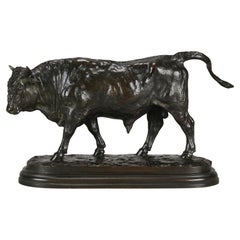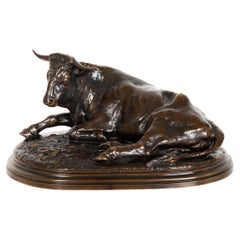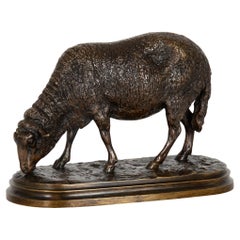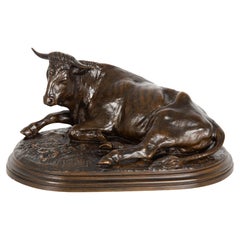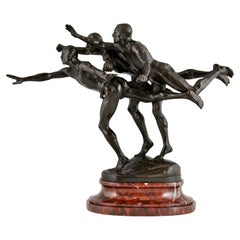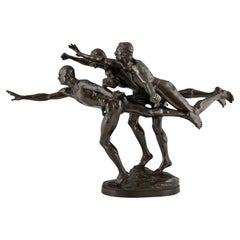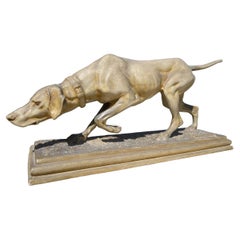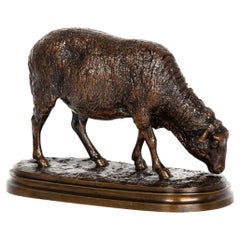Rosa Bonheur Decorative Objects
Rosa Bonheur was among the most accomplished female painters of the 19th century, a time when women were typically not encouraged to pursue fine arts as a profession. Bonheur never married and lived openly as a lesbian. She is remembered for her realist animal paintings and highly detailed bronze animal sculptures.
Bonheur was born in Bordeaux, France, in 1822. Her mother died when she was just 11. Her father, a painter, believed in female education and supported her artistic pursuits. He oversaw Bonheur’s painting education after her unsuccessful apprenticeship as a seamstress.
Bonheur rose to prominence relatively early in her career. In 1848, the French government commissioned a piece for an exhibition at the Paris Salon. The resulting painting, Ploughing in the Nivernais, is today in the collections of the Musée d’Orsay in Paris. Around this time, she began a relationship with fellow artist Nathalie Micas. The pair remained together for the rest of Micas’s life.
Bonheur’s most famous painting, The Horse Fair, was exhibited at the Paris Salon in 1853 and completed in 1855. It is a depiction of the horse market, where Bonheur went twice a week for a year and a half to work on her sketches. She applied for a police permit to wear men’s clothing for comfort and to dissuade attention. The painting, which measures eight feet across, is in the collections of the Metropolitan Museum of Art in New York.
In 1855, Bonheur’s art dealer introduced her work to the United Kingdom, where her art proved even more popular than in her home country. Her financial success allowed her to move to a large property near Fontainebleau, France, in 1859, where she lived for the rest of her life. It has since been renamed Château de Rosa Bonheur and includes a museum dedicated to her work.
Bonheur was awarded the decoration of the French Legion of Honour in 1865 and was promoted to Officer of the Order in 1894, becoming the first female artist to receive the honor. In 1893, she exhibited at the World’s Columbian Exposition in Chicago.
Bonheur died in 1899 at the age of 77. She was buried in Père Lachaise Cemetery next to Nathalie Micas.
On 1stDibs, find a collection of Rosa Bonheur’s sculptures.
19th Century French Art Nouveau Antique Rosa Bonheur Decorative Objects
Bronze
19th Century French Romantic Antique Rosa Bonheur Decorative Objects
Bronze
19th Century French Romantic Antique Rosa Bonheur Decorative Objects
Bronze
19th Century French Romantic Antique Rosa Bonheur Decorative Objects
Bronze
1890s French Romantic Antique Rosa Bonheur Decorative Objects
Marble, Bronze
1890s French Romantic Antique Rosa Bonheur Decorative Objects
Bronze
Late 20th Century Egyptian Moorish Rosa Bonheur Decorative Objects
Bronze
1890s French Napoleon III Antique Rosa Bonheur Decorative Objects
Bronze
19th Century French Neoclassical Antique Rosa Bonheur Decorative Objects
Bronze
1880s French Antique Rosa Bonheur Decorative Objects
Bronze
2010s British Organic Modern Rosa Bonheur Decorative Objects
Bronze
19th Century Italian Antique Rosa Bonheur Decorative Objects
Metal, Bronze
21st Century and Contemporary Italian Rosa Bonheur Decorative Objects
Bronze
19th Century French Antique Rosa Bonheur Decorative Objects
Marble, Bronze
Late 19th Century French Antique Rosa Bonheur Decorative Objects
Bronze
Early 1900s Antique Rosa Bonheur Decorative Objects
Bronze
19th Century French Antique Rosa Bonheur Decorative Objects
Terracotta
19th Century French Romantic Antique Rosa Bonheur Decorative Objects
Bronze
1890s French Other Antique Rosa Bonheur Decorative Objects
Bronze
19th Century French Romantic Antique Rosa Bonheur Decorative Objects
Bronze
Late 19th Century French Antique Rosa Bonheur Decorative Objects
Marble, Bronze
1880s French Antique Rosa Bonheur Decorative Objects
Bronze
19th Century French Romantic Antique Rosa Bonheur Decorative Objects
Bronze
19th Century French Antique Rosa Bonheur Decorative Objects
Bronze
19th Century French Antique Rosa Bonheur Decorative Objects
Bronze
19th Century French Antique Rosa Bonheur Decorative Objects
Bronze
19th Century French Romantic Antique Rosa Bonheur Decorative Objects
Bronze
19th Century French Romantic Antique Rosa Bonheur Decorative Objects
Bronze
Rosa Bonheur decorative objects for sale on 1stDibs.
Creators Similar to Rosa Bonheur
- 1stDibs ExpertMarch 22, 2022Rosa Bonheur painted animals because she had a deep love for them. The French artist also produced realistic sculptures depicting various animals. Animals were a part of her daily life, as she had many pets, including lions, sheep, horses and gazelles. You'll find a range of Rosa Bonheur art on 1stDibs.
